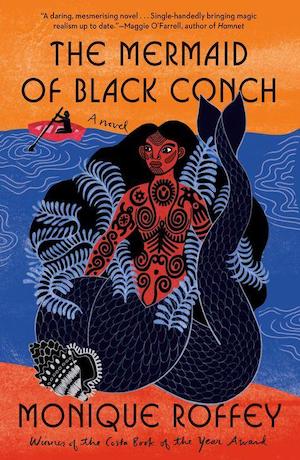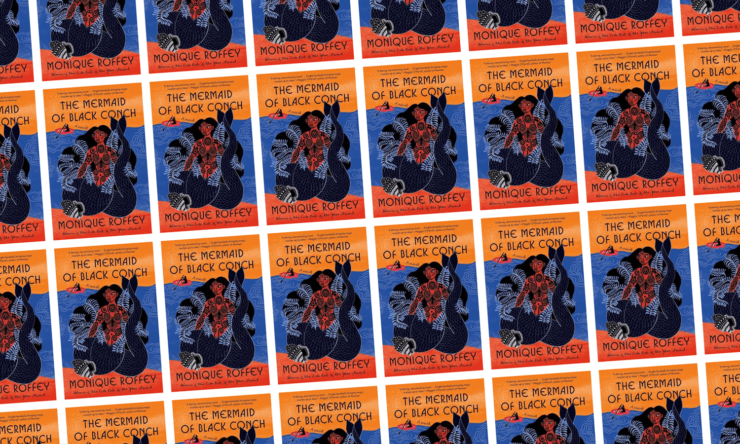1976, on a fictitious Caribbean island, a young local fisherman smokes a joint in his boat while waiting for the catch to come in. When he starts to strum his guitar, he attracts the attentions of a mermaid, a creature he first thinks he’s hallucinating. But he isn’t—there really is a mermaid, one who makes him tremble with ‘desire and fear and wonder because he knew what he’d seen. A woman. Right there, in the water. A red-skinned woman, not black, not African…Red. She was a red woman, like an Amerindian.’ And so starts Trinidadian born British writer Monique Roffey’s latest novel, the award winning The Mermaid of Black Conch.
Roffey’s titular mermaid is Aycayia, who was once a beautiful young woman of the indigenous Taino people, transformed into a mermaid by the curse of jealous women. The Taino were later wiped out by western ‘explorers’, who showed up looking for the usual colonial loot of gold and spices, but when they found that there was not enough profit to be made from these on the islands, they decided of course to instead commodify the Taino people themselves, and began what we now know to be the usual western colonial process of trafficking slaves. As seen in Columbus’ horrific legacy all over the world, the Caribbean being no different, the Taino were used, abused, and exposed to diseases to which they had no natural immunity. Soon, disease and the treatment of a people as a disposable labour force lead to a sharp decline in the indigenous population. What remained of the Taino were eventually absorbed into the postcolonial mix of different races, and thanks to a ‘paper genocide’, they were considered extinct for a very long time.
‘Red people were my people / all killed from disease/ and by the murderer admiral’, says Aycayia, in one thread of the multiple narratives that make up The Mermaid of Black Conch. The other’s are David’s story written in his journals, in retrospect as an older man, and the third is that of an omniscient narrator, who tells us more than either Aycayia or David may know. All three come together holistically, and with aplomb, in a story that’s evocative and reminiscent of oral storytelling traditions.
Buy the Book


The Mermaid of Black Conch
This isn’t a basic romance between a mermaid and a human in the more obvious of ways though. Aycayia is a powerful ancient who has spent decades in the sea, and though she is entranced by David’s guitar, the two do not meet properly until after she is captured by a father and son duo of American tourists, who show up on St Constance from Florida for the sports fishing contest. Their capture of her is horrific, with Moby Dick levels of violence and power and hunger and aggressive masculinity at play. It is, of course, also a reminder of the violence with which the indigenous tribes were subjected to when Columbus showed up.
When, after hours and hours of thrashing waves and violence, she is finally pulled in, ‘the local men stared. They felt a sense of blasphemy; this was something they shouldn’t be doing.’ But‘She was like a magnet. She was a woman hooked, clubbed, half-dead, half-naked, and virgin young’, when they string her up alongside the marlin that have also been caught from the same seas. The men go off to drink (to celebrate their victory, or drown their guilt), all but David, who cuts the mermaid down and sneaks her away to his house, without anyone seeing.
Slowly, while immersed in a tub of water in his bathroom, Aycayia begins to transform back into a woman. The transformation passages are grotesque and fascinating, gruesome stuff of body horror tales—‘her hands were the first to change; the webbing fell off in clumps, like grey-pink jello, to the floor…Her ears dripped sea water and small sea insects climbed out. Her nostrils bled all kind of molluscs and tiny crabs.’ Eventually, her tail falls off, and she then has to learn to walk again, on what was until recently only the memory of legs.
Aycayia is a woman reborn, and a catalyst for change in the people around her. After centuries spent in the sea as a vast, powerful but ultimately lonely creature, she slowly regains her humanity, forms bonds with those who care for her. But the curse that banished her to the sea lingers on, over time and tide, and Aycayia remains the other, remains a figure of lust, envy and jealousy to many. But to David, she is someone with whom he must examine his own understanding of love, of possession and his ‘own history as a man’. To Miss Rain, a descendantof the man who had once owned the island, a ‘white woman with Creole song in her mouth’, Aycayia represents the island’s past, forcing Miss Rain to examine the awkward space she inhabits on the island, as a sort of landlady to all, but also in so many ways, a local.
Miss Rain understands what it is like to be othered by the only people you’ve ever known, and when David lets her into his secret, she teaches Aycayia how to communicate, with help from her deaf son Reggie, who is the first human to truly connect with the mermaid in a pure, innocent way that places no demands, expectations or assumptions on who or how she should be.
Jean Rhys’ Wide Sargasso Sea set up and defined the mad woman in the attic trope for so long that it became a representation of the woman scorned in Caribbean literature. But The Mermaid of Black Conch forces that trope away, and explores different depths.
Possession of women by men, especially when enabled by colonial hangovers, is very much a concern of the story. As is the burden of whiteness, colonisation and the inherited legacy of both. The sheer cruelty that humans are capable of; whether in the form of ancient curses that run deeper than any sea, or in how they treat those they do not recognise, or in how easily, casually one race can wipe out another—these are all Roffey’s concerns in The Mermaid of Black Conch. Written partly in a beautiful rhythmic, lilting patois that creates a bold vision, it’s easy to find yourself deeply immersed in Roffey’s world, in a narrative that shows us how magic realism is oftentimes the best, most appropriate genre for post colonial fiction.
The Mermaid of Black Conch is published by Knopf.
Mahvesh loves dystopian fiction and appropriately lives in Karachi, Pakistan. She writes about stories when not wasting much too much time on Twitter.










